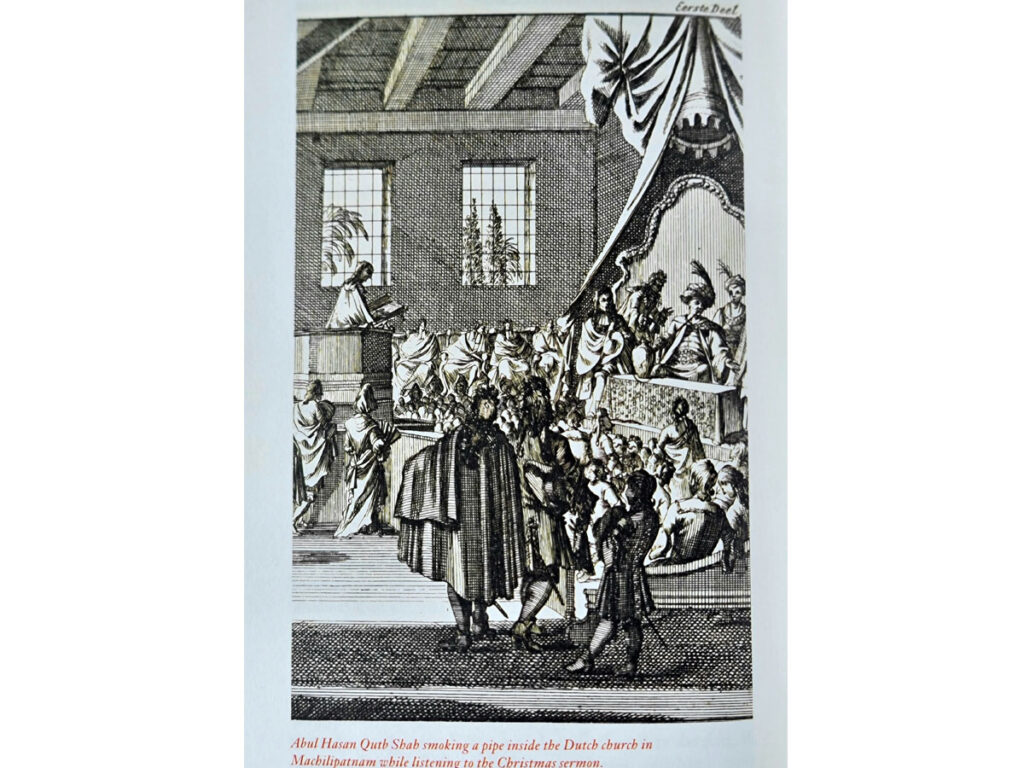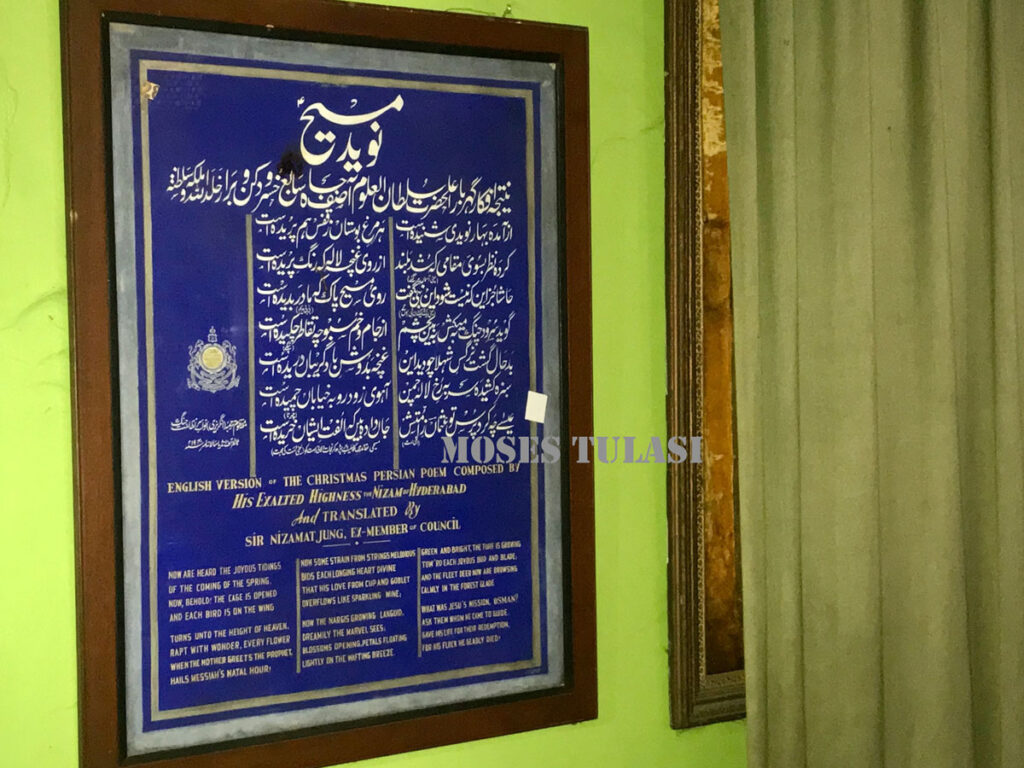An amusing Christmas anecdote from the late 17th century Hyderabad is found in Serish Nanisetty’s recent book Golconda/Bagnagar/Hyderabad – Rise and Fall of a Global Metropolis in Medieval India. This was on a 2-month pleasure trip Abul Hasan Qutub Shah made out to the east coast (Machilipatnam) taking a break from court intrigues and the ever-looming threat from the Mughals. His entourage consisting of elephants, bejeweled palanquins, army of soldiers and workers reached just in time for Christmas.
The Dutch traders at the coast welcomed Abul Hasan into the Church they had built within the double-storied warehouse and arranged a throne beside the altar for him for the Christmas service. Here was Hyderabad’s most culturally diverse Sultan, smoking his hookah pipe and listening to the Christmas sermon. Fortunately for us, this once-in-lifetime scene caught an artist’s imagination.
At the end of the sermon, Abul Hasan didn’t have any questions perhaps because the Christmas story would have been far too familiar to him from Islamic sources. However, he did wonder how the Christians managed with monogamy and also wanted the women in his entourage to mingle with the Dutch women for a cross-cultural experience.
It appears the interactions between medieval Muslims and Christians in the state were spared the burden of the animosity due to the political and civilizational differences between European Christendom and the Islamic world.

Global Metropolis in Medieval India
A closer look at the early history of Christian-Muslim interaction suggests there were at least some Muslim sects/groups who observed the birth of Jesus. This practice one can only imagine withered away due to the aforementioned animosity. Here is a snippet from the book “Jesus in Shiite Narrations” by Mahdi Muntazir Qa’im
“Abu Ibrahim [Imam Musa Kadhim (‘a)] (745-799 AD) said ‘As for the mother of Mary, her name was Mirtha, in Arabic, Wahibah (gift). As for the day on which Mary conceived, it was Friday at noon, and that was the day that the Ruh al-Amin (the trustworthy spirit) came down, and there is no festival better than this for Muslims. Allah, the Blessed and Almighty, magnified it, and Muhammad (S) magnified it and He ordered that it should be a holiday, and it was Friday.’”
Reportedly, the oldest Christian shrines in Hyderabad state date back to the 17th century built by the French and Dutch. Churches built from 19th century onwards are better documented with St John’s Church in Secunderabad from 1813 built for the British troops still retaining the original structure. This Church is named after a prophet of Islam and Christianity – Yahya a.s ibn Zachariah a.s. (John the Baptist).
It is well known that the seventh Nizam, Osman Ali Khan was very warm to religions minorities especially Shia Muslims, Parsis and Christians. He had attended the midnight mass during Christmas in 1950 along with 60 courtiers all dressed in suits. He had gifted a clock, a European oil painting of blessed mother and Christ as a child, and chandeliers in 1953 to the cathedral, according to historian M.A. Qayyum. He also laid the foundation stone of the unique Octagonal architecture Church in Khairatabad “Shrine of Our Lady of Health” in 1954, the permission of which was granted by his father, the sixth Nizam.
The Nizam’s Farsi poem on Jesus “Naved Masih” starts with the story of Christmas, a translation of which is done by Sir Nizamath Jung. The poem adorns the wall of the Aza Khan-E-Zehra Ashoorkhana.
“NOW ARE HEARD THE JOYOUS TIDINGS
OF THE COMING OF THE SPRING
NOW, BEHOLD! THE CAGE IS OPENED
AND EACH BIRD IS ON THE WING
TURNS UNTO THE HEIGHT OF HEAVEN
RAPT WITH WONDER, EVERY FLOWER
WHEN THE MOTHER GREETS THE PROPHET,
HAILS MESSIAH’S NATAL HOUR!”

The census reports of Hyderabad state suggest the Christian population increased from 0.2% in 1901 to 1.6% in 1951 with the largest spikes in the decades of 1921-31 and 1901-11. Christians in 1901 were concentrated in urban areas whereas by 1951 the tide turned with rural areas accounting to 74%. Districts wise, the largest concentration of Christians in 1951 was in Warangal, Medak, Hyderabad, Bidar, Nalgonda and Aurangabad in that order.
The growth of Christian population in Hyderabad owes to several factors over centuries like the work of American and English missionaries, migrations from neighboring states, anti-caste movement among Dalits and backward classes etc. It is difficult to draw comparisons post 1956 because of the trifurcation of state and it is particularly challenging to document Christian population because of the constitutionally problematic 1950 Presidential Order barring non-Hindu SC Christians and Muslims from availing government welfare schemes for SCs.
With so much complexity associated, the history of Christianity in two Telugu states needs more exploration than currently available in public domain. Andhra Pradesh is seen by contemporary anti-caste scholars as a Christianity revolution state and there is some evidence available to that effect, at the helm of it is, published in 2019, a doctoral thesis turned into a monograph “Christian Missions and Conversions; A historical, sociological and anthropological study of the depressed castes in India (focusing on coastal Andhra), 1850-1950 by Santha Kumari Varikoti-Jetty.
A similar study is waiting to be undertaken for Telangana.
Moses Tulasi is a Hyderabad based filmmaker who occasionally writes on history and culture

